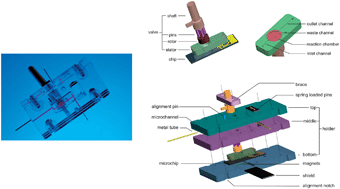This work features the design, fabrication and characterisation of a miniaturised electroanalytical lab on a chip that allows the performance of a complete bioassay, from the capture of magnetic particles through their functionalisation and sample incubation to the detection of electroactive reaction products. The system is built using mainly polymeric materials such as PMMA and PDMS and fast prototyping techniques such as milling and moulding. The system also includes a set of microelectrodes, photo-lithographed on a silicon chip. The novelty lies in the design of the rotary microvalve, which contains a microreactor so that various reaction and incubation steps can be carried out in isolation from the detection event with zero dead volume. This avoids contamination and fouling of the electrodes by proteins or other organic matter, and extends the useful lifetime of the detector. The system operation is demonstrated by a model example, consisting in the functionalisation of streptavidin-coated magnetic particles with biotinylated β-galactosidase over periods ranging from 5 to 15 min, at which point the particles saturate. Although the system is intended for the development of enzyme-based electrochemical bioassays, the concept of its rotary microreactor can be applied more broadly.

You have access to this article
 Please wait while we load your content...
Something went wrong. Try again?
Please wait while we load your content...
Something went wrong. Try again?


 Please wait while we load your content...
Please wait while we load your content...